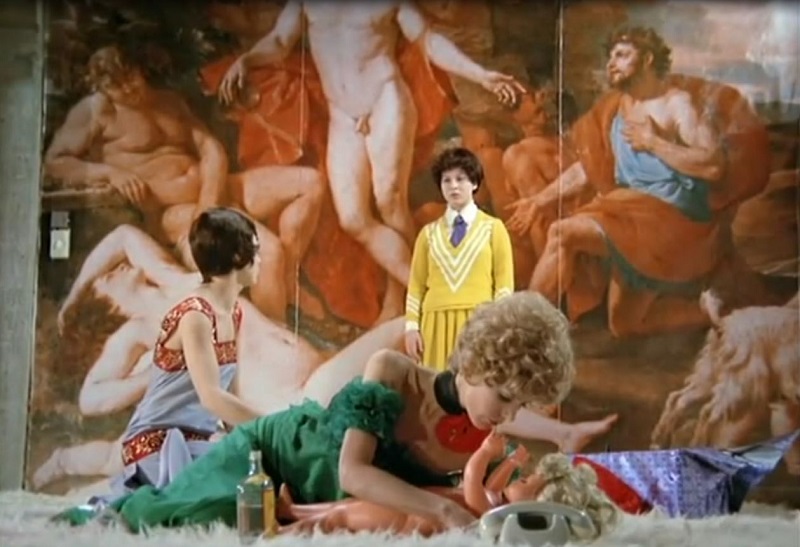CYCYCYCLOPS
The Bitter Tears of Petra Von Kant and Ideas of Theatricality in Cinema
by Mike Corrao
This mise-en-scene alludes to a certain type of cinema, which is a veiled limb of theater (the theater). With its fixation on our confinement in one place & the odd way that voices are able to materialize as weighty objects.
↓
I am thinking of (The Bitter Tears of) Petra Von Kant’s cruelty and the way that it seems to press into the bedframe and imprint itself on the rug. Without allowing language the room to disperse, it has instead collected into a globular formation.
↓
It is like pitch or slime. It only moves when enough material has gathered that it is no longer able to maintain its shape, or after enough time has passed that gravity has grated away at its will.
↓
We are standing completely still. This is a deserted spot, and pitch-black.
↓
What turned it all to disgust? Is it the mask that I’m wearing? Or the labyrinthine way that we’ve arranged the hallways of this building?
↓
If language must gather, if we must confine ourselves to some set of spatial parameters, then let me have my fun.
↓
To those with weak stomachs in the audience, it is okay if you vomit. I am vomiting right now. It’s okay to vomit. Even here, we are still in the psychic blast zone.
↓
A voice (weighty object) surfaces from within the stem. Your ancient reptilian brain hisses something that sounds like disco. It emits a naseauting signal.
↓
We can’t tune-in unless you want to.
↓
The impressions on Petra’s rug resemble an eel or a lamprey.
↓
In this next scene, I need you to coil yourself around the wriggling mass, and look for the pink under its translucent skin.
↓
The next assemblage will be entombed against your bosom. Now is not the time
↓
or cruelty. Let it squirm in your embrace.
↓
Ugliness is a kind of death.
↓
Petra is wailing about someone that I don’t recognize and the audience is positioned at an angle where they are only able to see the lower half of the room. Petra’s crumpled body and another woman’s legs.
↓
I am not interested in “devices.” We are speaking thru an arrangement of mirrors.
↓
Argos is weaving a wreath of eyes for you to place around your own. This is the height of fashion.
↓
I am adorning myself in live heatmaps of crabs en masse around a deserted body (and pitch-black). I am hoping that we can approach some kind of demonology of the coward. Perhaps as a new tarot card, something to be read and misinterpreted.
↓
An oracular scene.
↓
I am drawing a triangle of symbols. The hilt, the ribcage, and the palm, which can be interlocked to create a corpse.
↓
The hilt belongs to a sword of many edges—it was made to create several cuts all at once.
↓
When the wound opens, we can read each path the blood creates. I hope that it will spill in the shape and weight of an eel.
↓
Or that it creates the impression upon Petra’s rug, perhaps as some kind of self-fulfilling prophecy. This is how all blood is meant to be used.
↓
As the means to produce children, or as the materials of a large painting. There is a lot of blood. It could be used to birth an adolescent or a mural.
↓
In the next scene, there are rags in the trash bin. I don’t know what they’re stained with. It is a vague mixture of browns.
↓
There is an ASMR device on the table. It emits a sound that fills my body with needles.
↓
The mass of text which has been dripping from Petra’s mouth is becoming unavoidably large. It is pulling the atmosphere from the room and making it difficult for us to hear one another.
↓
A gothic depiction of foreclosure.
↓
Our fixation on a singular space may at first appear as (or even have been conceived as) a need to stablize the positioning of the theatrical event, but I would like to instead contextualize it as a potential to create intimacy.
↓
Our focal point is the interaction. Between subjects, between subjects and their environment, between facets of the environment.
↓
I feel an intense understanding of the apartment (the shag rug, the large classical tableau, the liquor cabinet, the easel). It is somewhere that I feel as if I have been. To a certain extent it is somewhere that you and I have occupied, however briefly.
↓
In this scene, it has only been an hour.
↓
Meanwhile outside
↓
The wreath of eyes creates a panoptic idol. It converts two-dimensional space into a three-dimensional model.
↓
I am occupying a fixed point nearly overlapping this surveyor.
↓
The mirror creates a secondary image that nearly replicates the original—if you were able to fill this bit in with some sort of shroud.
↓
We are entering the womb of architecture.
↓
My perception of this is as an interior art—which might be said of many other mediums, but perhaps here it is better thought of as an art of confinement, or of immobility.
↓
It is only you and I here.
↓
The text and… whatever you call yourself.
↓
A globular eel of blood, a jury-rigged argus, part of the imagined mise-en-scene.
↓
Our evening friend is leaning against the balcony watching a body hang from the tree behind the cafeteria. He is saying that the womb of architecture does not fully explain what has been happening lately.
↓
It does not explain the body.
↓
It does not explain why Petra is unwilling to receive the cruelty that she gives to others.
↓
It does not explain why there is a small hole in my chest that is growing.
↓
Or the void that it is revealing thru me.
↓
I have nothing to hide!
↓
Meanwhile inside,
↓
The nauseating signal has become nearly deafening. The source remains obfuscated. The ancient reptilian brain originates from the brain stem, but whose I am not fully sure. At first I thought yours, & then I thought mine.
↓
There is a certain sadness which can be transmited through the image of the wailing Petra.
↓
The voices (weighty objects) articulated as a lump on the rug might corprealize that sadness, but only in some shallow way. There is something more there than I am able to vocalize.
↓
Maybe it is important that such feelings remain unconveyable.
↓
In these cases I wear a veil over my face.
↓
Someone out of frame says, “I want my paintings to be a source of disturbance and irritation.” I think it is Francis Bacon, but I cannot see them. They are out of frame.
↓
The faces above the stage have been replaced with an ox-head and horse-face.
↓
We are arranging the mirrors from earlier at key points in order to create the shadow of a bag of milk.
↓
I know he’s not here, it’s not a terrible thing. I know he’s not here.
↓
The lump is smuggled out of the scene and is replaced with a stenorlynchus covered in algae. We do this for political reasons.
↓
In order to prevent the formation of further coagulates, Petra is led from the rug to the hardwood (by the mannequin), and given an oil-hell mask to conceal her face beneath.
↓
It looks at the wreath of eyes, and in return, an ocular ray envelopes the room in sight (a mirage of pleasant imagery, an experimental gestalt of sorts). It completely penetrates the subject’s skull, which is only held together by the rigidity of her mask.
↓
We will build a straw effegy to cleanse the room of your cruelty, and when it has fully normalized, the mirages formed will be retrieved and smuggled away in the same fashion as the coagulate.
↓
It is difficult to explain where we are standing now, still in front of the audience, still disguised as something ‘cinematic’ if we can say so without vomiting.
↓
The audience is staying quiet and only stepping away to blink or relieve themselves.
↓
The signal is difficult to ping now.
↓
Trying to find it gives me a headache. It makes me nauseous again—something I thought I had gotten over.
↓
The ancient reptilian brain is singing Sun Ra’s Nuclear War, expecting me to repeat the words back.
↓
When the eel of blood arrives at its destination, we will celebrate with a feast, and whoever has agreed to stay with Petra will comb the indents from her carpet.
↓
This is the erotic morphological communique.
↓
I won’t be content until it’s completely destroyed.

About the Author
Mike Corrao is the author of numerous works, most recently Cephalonegativity (Apocalypse Party) and Desert Tiles (Equus Press). Along with earning multiple Best of the Net nominations, Mike’s work has been featured in publications such as 3:AM, Collagist, Always Crashing, and Denver Quarterly. He lives in Minneapolis.
